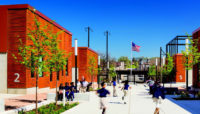Architectural Record: You do so many things—you act, you model, you rap—how did you get involved with this TV series as both host and executive producer?
Spike TV actually approached my agent and me. I was open to it because I am always open to ideas. I am drawn to art, even if it’s not art that I really know much about. I thought it would be a great venture for me to host the show and learn—it was exciting for me.
So this was your first experience with furniture design?
Yes, that’s why I represent the consumer. Like any other person, I’ve had to buy furniture for my home, and I actually enjoy picking out things because it is applying your taste and your vision. It’s like, “Do I like this color for this room? Does this go with this?” It was really about me being the consumer and giving my perspective as a judge.
How would you describe your design aesthetic? What are you drawn to?
I am drawn to midcentury modern, with character. I am not the person that feels like everything has to be one way; I think you can mix and match. I am drawn to things that are warm and comfortable. Because I am artist, I like things to be unique, but it still has to be, like, livable. I don’t want my house to feel like a museum.
What does your house feel like? Do you have a favorite piece of furniture?
My house is comfortable. The furniture that I like is warm, the design is simple and clean, but with nice warm color. The couch is comfortable.
You are first and foremost a musician. Are there parallels between music and furniture design or architecture?
I think the similarities lie in the vision and creativity and talent to be a great builder, designer, architect, artist, musician. It takes training and work—even when you are talented and passionate.
There’s been this interesting intersection between hip-hop and the design world. Kanye West has been really involved in architecture and even said that a lamp by Le Corbusier inspired his latest album. Why do you think both the music world and design world are intersecting?
I think a lot of the artists that define hip-hop culture are first artists—they’re not just songwriters or hip-hop artists, they have visions. Obviously Kanye is very much, to me, a genius. He has all kinds of visions for all types of art, that’s why he can translate that into architecture, design, and fashion. And so can Pharrell [Williams]. We come into the game thinking about hip-hop, but our world just became open. There’s something going on in the universe or the atmosphere where we think, “Oh wait, I can actually act, I can learn about design.” I think it’s having a thought process that’s saying, “Man, we can be diverse and do different things and approach different aspects of art.”
Any plans for a second season of Framework?
That’s really going to be up to Spike TV.
What do viewers have to look forward to in the next half of the series?
There are definitely going to be some new fresh challenges. I think the builders really start to step up in certain areas.
What does it feel like to send people home on the television show?
I mean, at first it was tough. It’s somebody’s dream. But now I know it’s part of the process. I also look at it, like, man, everything is part of our destiny and everything is there for us to get better. If you don’t make it to the top on the show, maybe you gained something. I do my best to be as honest as possible, and be respectful, and send them home motivated.



